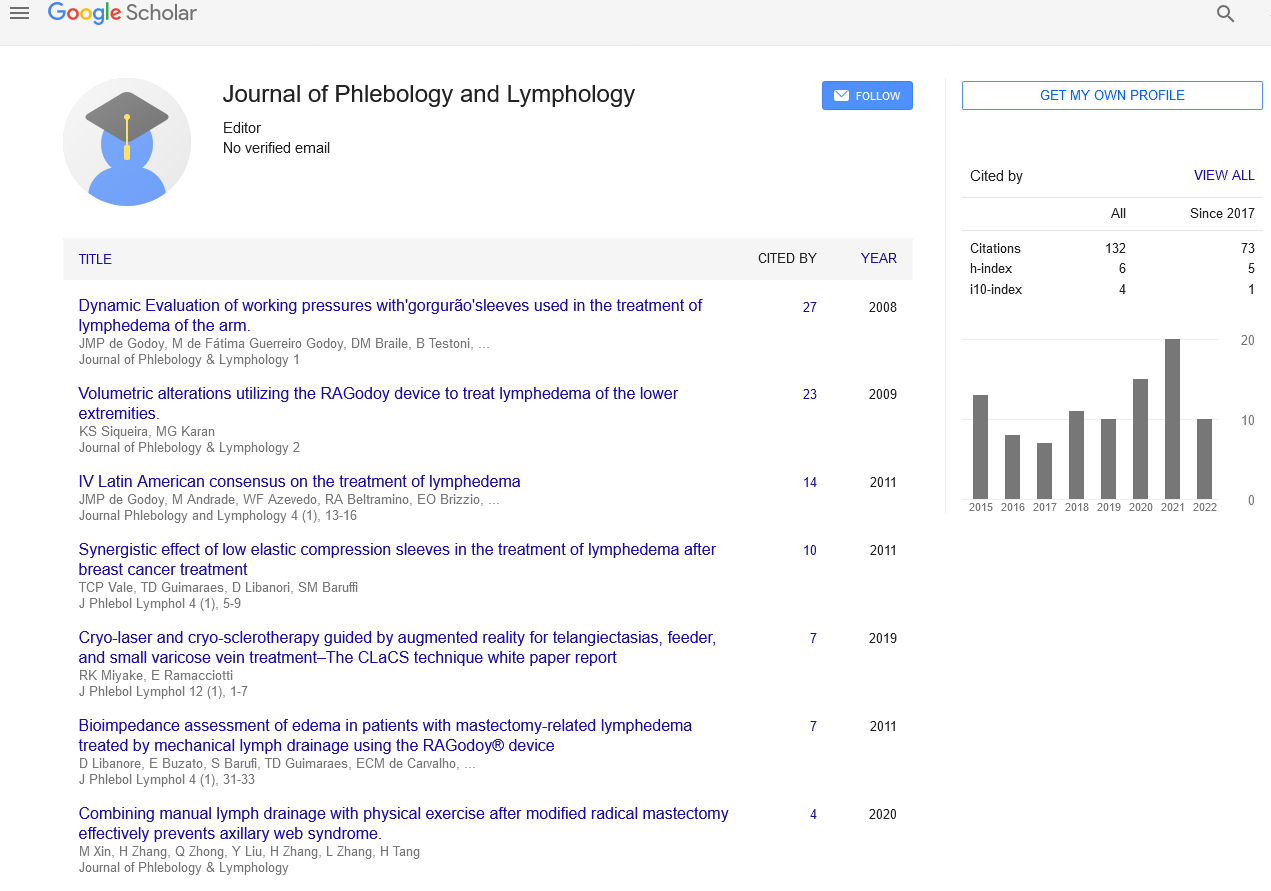Hemosiderin in urine is a sign for chronic venous insufficiency
Received: 05-Mar-2022, Manuscript No. PULJPL-22-4660; Editor assigned: 08-Mar-2022, Pre QC No. PULJPL-22-4660; Accepted Date: Mar 07, 2022; Reviewed: 18-Mar-2022 QC No. PULJPL-22-4660; Revised: 23-Mar-2022, Manuscript No. PULJPL-22-4660; Published: 29-Mar-2022
This open-access article is distributed under the terms of the Creative Commons Attribution Non-Commercial License (CC BY-NC) (http://creativecommons.org/licenses/by-nc/4.0/), which permits reuse, distribution and reproduction of the article, provided that the original work is properly cited and the reuse is restricted to noncommercial purposes. For commercial reuse, contact reprints@pulsus.com
Abstract
Chronic venous insufficiency (CVI) is one of the most serious health issues in the industrialized world. The etiology of trophic skin alterations is complicated by iron accumulation in tissue. The goal of the study was to see if there was a link between the clinical severity of venous insufficiency and hemosiderin excretion in the urine glymphatic.
Key Words
Chronic venous insufficiency; Etiology; Hemosiderin; Ulcers; Microcirculation
Opinion
Essential or auxiliary noxae may influence the G-Ls. Essential noxae are the hereditary aquaporin-4 channelopathies or auto-antibodies that straightforwardly harm aquaporin-4. Auxiliary noxae are the confusions of the intra-extra cranial hydrodynamic at different levels prompting CSF course changes. CSF stream waves, hemodynamic, and neuronal electrical movement motions associate in rest. CSF stream disappointment follows a decrease of blood vessel pulsatility, and an expansion in intracranial venous strain because of the limitation of intracranial veins or expanded extracranial venous tension communicated to the cerebrum. CSF stream stifle during breath-holding. Additionally, trash in the CSF spaces or their hindrance for inherent, provocative, irresistible, hemorrhagic, neoplastic, and horrible cycles weakens CSF dissemination.
Disappointment of the CSF dynamic associates with G-Ls stream cycles and triggers the "G-Ls pathology." If CSF doesn't stream proficiently, it deteriorates and aggregates in the perivascular spaces, extending and becoming apparent at imaging, as seen in neurodegeneration conditions Likewise; minor changes in CSF pressure, tissue pressure, or vascular capacity might adjust the state of perivascular spaces, prompting a modified stream dynamic in perivascular spaces and auxiliary stream impedance. Arteriolar hypopulsatility likewise hampers perivascular CSF surge, as estimated when worldwide CSF dissemination stops. Test proof backings this instrument, since diminishing plasma osmolality, practically reenacting perivascular spaces blockage, prompts eased back G-Ls inflow. Besides, debilitation of respiratory movement could lessen perivascular spaces flushing and disappointment of the perivascular CSF outpouring prompts "perivascular spaces harm".
Perivenular contribution may likewise happen. Accordingly, cerebrospinal-interstitial liquid could likewise deteriorate in the interstitium because of the ascent of obstruction on the venous side of perivascular spaces from diminished liquid efflux. The interstitial spaces are then immersed, interstitial mass stream hindered, and interstitial and probable intracranial tensions increment. Aggravations at the interstitium level may, furthermore, harm the perivascular astrocyte end feet, with injury of aquaporin-4 water channels, a further dialing back of interstitial liquid stream, and self-supported interstitial clog.The occasions at the degree of interstitial spaces arrange the "interstitial harm." Neuroinflammation and responsive gliosis propagate the noxae by resounding the previously mentioned obsessive strides in an endless loop.
Taking into account how G-Ls capacities, its persistent disappointment might prompt dysregulation of mind squander particle leeway, intra-extracellular water, particle homeostasis, and CNS invulnerable reaction changes. In addition, since aquaporin-4 is associated with ependymal advancement and physiology, G-Ls harm might disturb the life structures and capacity of CSF spaces.
We arrange messes finishing in neurodegeneration with another way:
- Proteinopathies
- Interstitial/cell water amassing and brain hyperexcitation pathologies
- Immune system cerebrum pathologies
- CSF resorption and stream aggravation
In the “G-Ls pathology" model, treatments to forestall neurodegeneration ought to target aquaporin-4 polymorphisms and changes; treatments pointed toward forestalling aquaporin-4-explicit IgG restricting are being scrutinized. Additionally, the anticipation of hydrodynamic aggravations connected with blood vessel flow can follow treatment signs for cerebrovascular sickness. The productivity of fundamental blood vessel stream might keep away from CSF stagnation at the perivascular spaces, while implantable siphon strategies can control the CSF pulsatility by volume changes in low blood stream circumstances in the canine. On the venous side, the hunt and revision of potential reasons for intracranial venous hypertension, including hepatic and aspiratory dysfunctions, may forestall or reestablish a decrease of the blood cerebrum stream and work with CSF flow. Also, CSF waste might switch venous hypertension, reestablishing interstitial liquid flow. However, CSF cleaning by shunting can limit the change of the life systems of subarachnoid spaces at the hour of the injury. Simultaneously, endothelial development factor medicines vow to address meningeal lymphatic vessel dysfunctions. In general, mediations at the intraextracranial hydrodynamic framework level might forestall CSF flow disappointment and "perivascular space harm." In equal, interceding on the CSF course unique by shunting can target "interstitial harm," making more space for the interstitial space the nature of night's rest monitors neurotoxic proteins' freedom, and treatments focusing on atomic instruments could advance G-Ls fix. At long last, since aggravation assumes a part by any means of the proposed course levels, mitigating treatment may be useful in different strides of the cycle. It would be vital to comprehend the time-course of the grouping of occasions in the "G-Ls pathology" and the limit of conceivable reversibility in any of its means to plot new restorative systems. To this end, the chance of utilizing dynamic attractive reverberation imaging to follow G-Ls, in little lab creatures and people different advances, could demonstrate instrumental in accomplishing this objective.. Considering the lack of correlation between haemosiderin urine excretion and the severity of venous insufficiency in our research and the very promising results of previous studies, it seems worth continuing attempts to standardize and objectivize this method.
Conclusion
Neurodegeneration is as of now not the after effect of a few heterogeneous mind illnesses however a definitive clinical/neurotic articulation of the extraordinary "G-Ls pathology," as the result of various variables classifiable in the edge of cerebral hydrodynamic aggravations.





